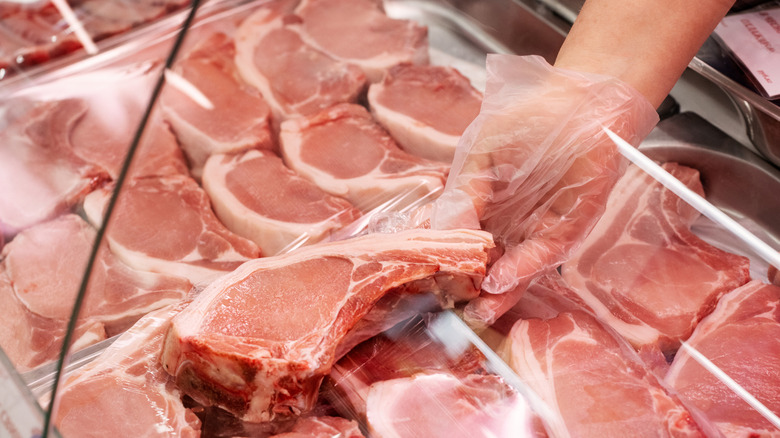The Pork Mistake You're Making Even Before You Start To Cook
When it comes to cooking pork, the very first mistake most home cooks make happens long before the skillet heats up: it's not knowing which cut of pork they're actually working with. Unlike chicken or beef, where the cuts are relatively straightforward, pork derives from a wide array of muscles, textures, and fat contents. To cook pork perfectly, you must first understand exactly what cut you've bought, because each one needs a different cooking method to shine.
We turned to chef K.C. Gulbro, owner of FoxFire Steakhouse in Geneva, Illinois, to get his advice on cooking perfect pork. Your first step is knowing the differences between the types of cuts. Gulbro explains, "Loin Chop [is] from the back, tender, lean, best for quick cooking. Rib Chop [is] from the rib section, well-marbled, juicy, flavorful." When it comes to the shoulder or blade chop, he explains, "[It's] from near the shoulder, more connective tissue, richer flavor, needs slower cooking." And if you were wondering about the sirloin chop, Gulbro describes it as "near the hip, often a bit tougher, good for braising, or grilling carefully."
Those slight differences in location matter; even though they're all pork chops, each has its own texture and fat pattern. Pork certainly has a tendency to be overcooked, so don't be afraid to serve your pork medium-rare. Knowing the difference in cuts lets you choose the right technique, so you can sear your pork chops without drying them out.
Match the cooking method to the right cut of pork
Cooking pork is not merely about following a recipe; it's about matching the cooking method to the cut. Tender, lean cuts like tenderloin, loin roast, or certain chops do best with high heat, quick-cook methods like pan-searing or broiling. These techniques lock in juices without overcooking. Tougher or fattier cuts like shoulder, shanks, or spare ribs need slow, moist heat. Chef K.C. Gulbro elaborates, "Cooking a loin chop low and slow will dry it out, while cooking a shoulder chop quickly will leave it tough."
Before you season your meat, read the package label beyond the word "pork." And, if nothing else, remember Gulbro's advice: "Knowing the cut helps choose the right cooking method (Grill/pan-sear for loin and rib; braise/stew for shoulder/sirloin)." If you're still not sure, you can always ask your butcher for the best cut of meat. Learn exactly where the cut comes from on the animal; and look at the marbling, thickness, and bone structure. Once you know that, you can make mouthwatering pork chops in the slow cooker (not the stove), and set yourself up for pork perfection.
Ultimately, the difference between dry, dull pork and juicy, mouthwatering success comes down to knowledge and respect for the cut. Master that, and every pork dish becomes a chance to show off just how well you know your way around the pig.

